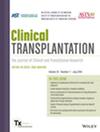Kidney Donors' Perceived and Measured Stress Levels Before and After Donation, a Longitudinal Cohort Study
Abstract
Introduction
Transplantation with a kidney from a living donor has superior long-term patient and graft survival compared to a kidney from a deceased donor. For a kidney donor, feelings of stress may exist at different stages of the donation process. The aim of the study was to evaluate living kidney donors’ perceived and measured stress levels before and after donation.
Methods
In this prospective observational cohort study with longitudinal follow-up, kidney donors were invited to answer three self-rating questionnaires targeting stress, vital exhaustion, and depressive symptoms the day before and two and six months after kidney donation. At the same time points, blood and saliva samples of insulin, glucose, and cortisol were collected.
Results
Analyses were based on data from seventy-five individuals, with a mean age 46.5 (11) years, 60% women. The kidney donors scored low in self-rating stress, exhaustion and depression both pre- and two and six months post-donation, and no correlations were established between self-reported measures and metabolic stress biomarkers. Post-donation, however, a gender difference emerged, with women reporting decreased vitality scores 32.1 (9.3) and 30.7 (11.6) at two and six months versus men reporting increased scores 35.8 (6.9) and 36.9 (7.1). Six months post-donation, women also reported more symptoms of depression than men, 12.2 (12.5) versus 6.4 (8.2) (p = 0.058).
Conclusions
Kidney donors’ self-reported and measured stress levels and depressive symptoms were low and did not change from pre-donation up to six months after donation. The low levels of subjective and objective stress reported by the donors support the limited risks associated with living kidney donation. However, six months post-donation, women reported more feelings of exhaustion and depression than did men. Practitioner points: (1) The low levels of subjective and objective stress reported by kidney donors support the limited risks associated with living kidney donation. (2) Because most kidney donors are women, the gender difference in perceived stress levels presented in this study is of clinical relevance. (3) A more structured psychosocial follow-up could enable the identification of individuals in need of more psychological follow-up post-donation.

 求助内容:
求助内容: 应助结果提醒方式:
应助结果提醒方式:


